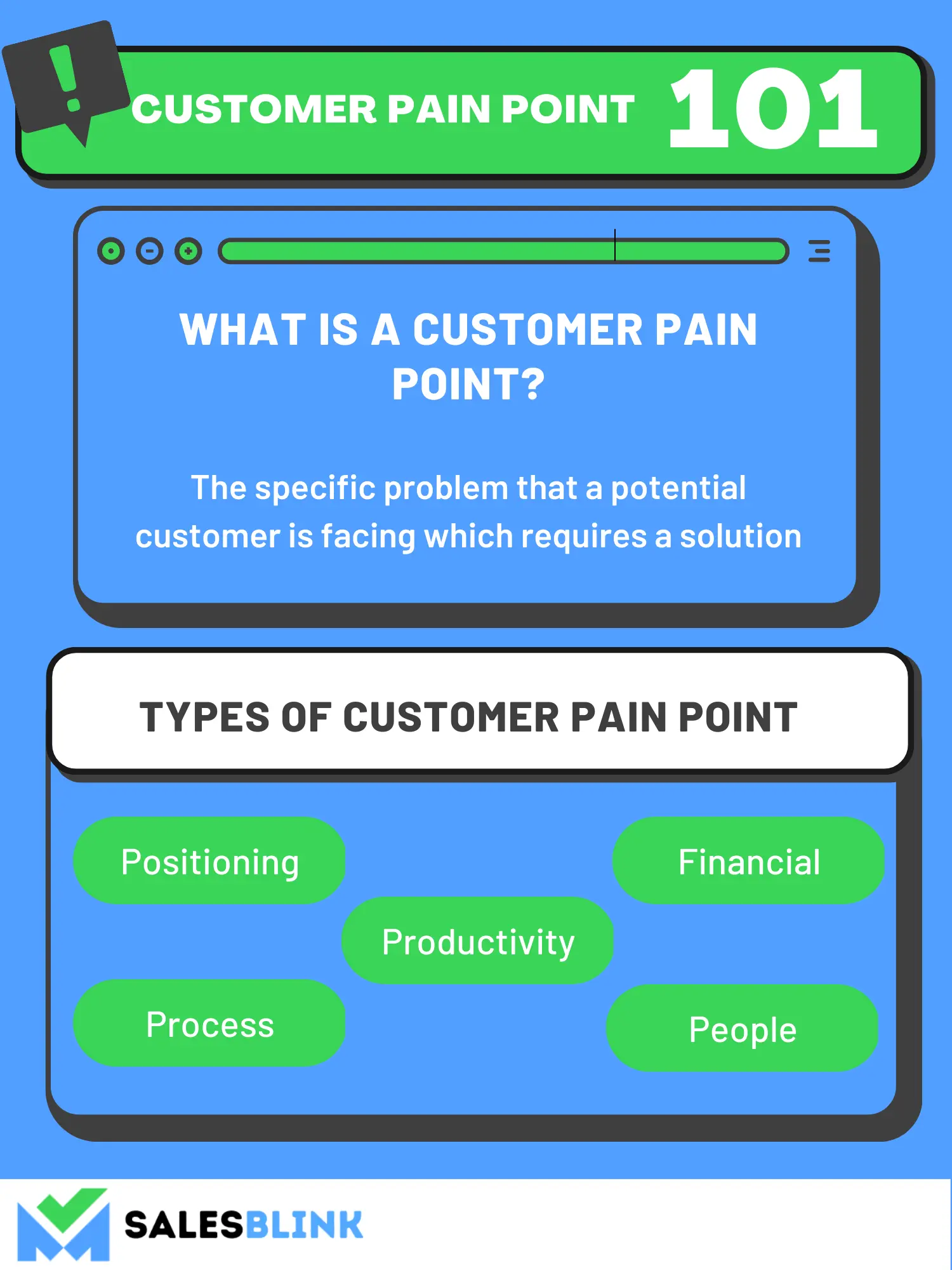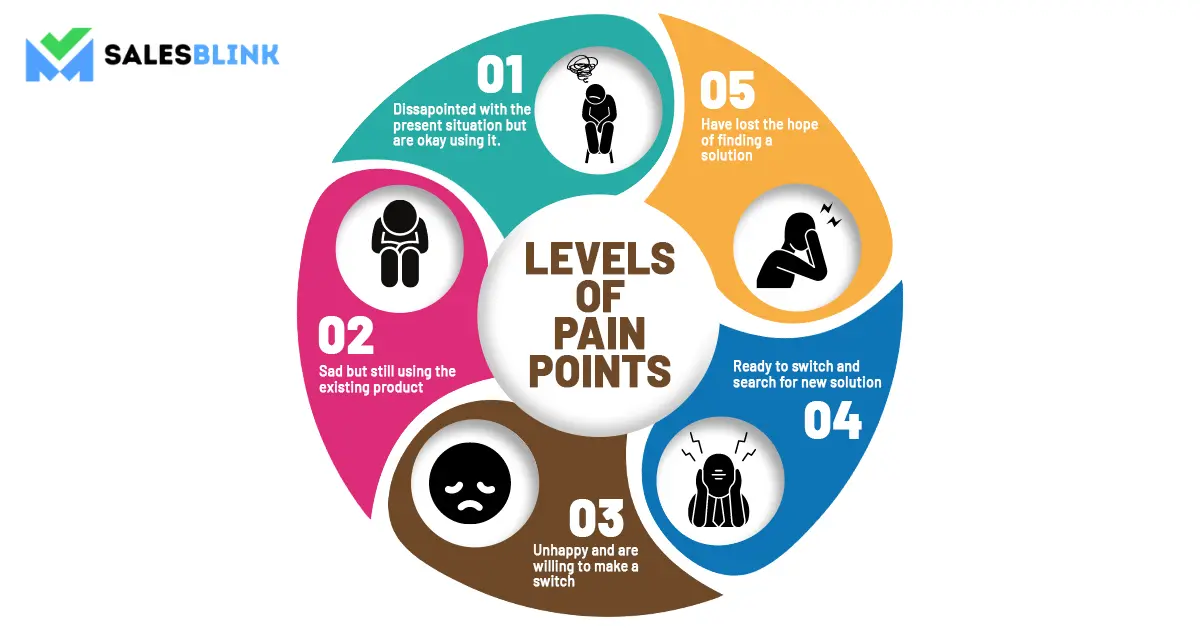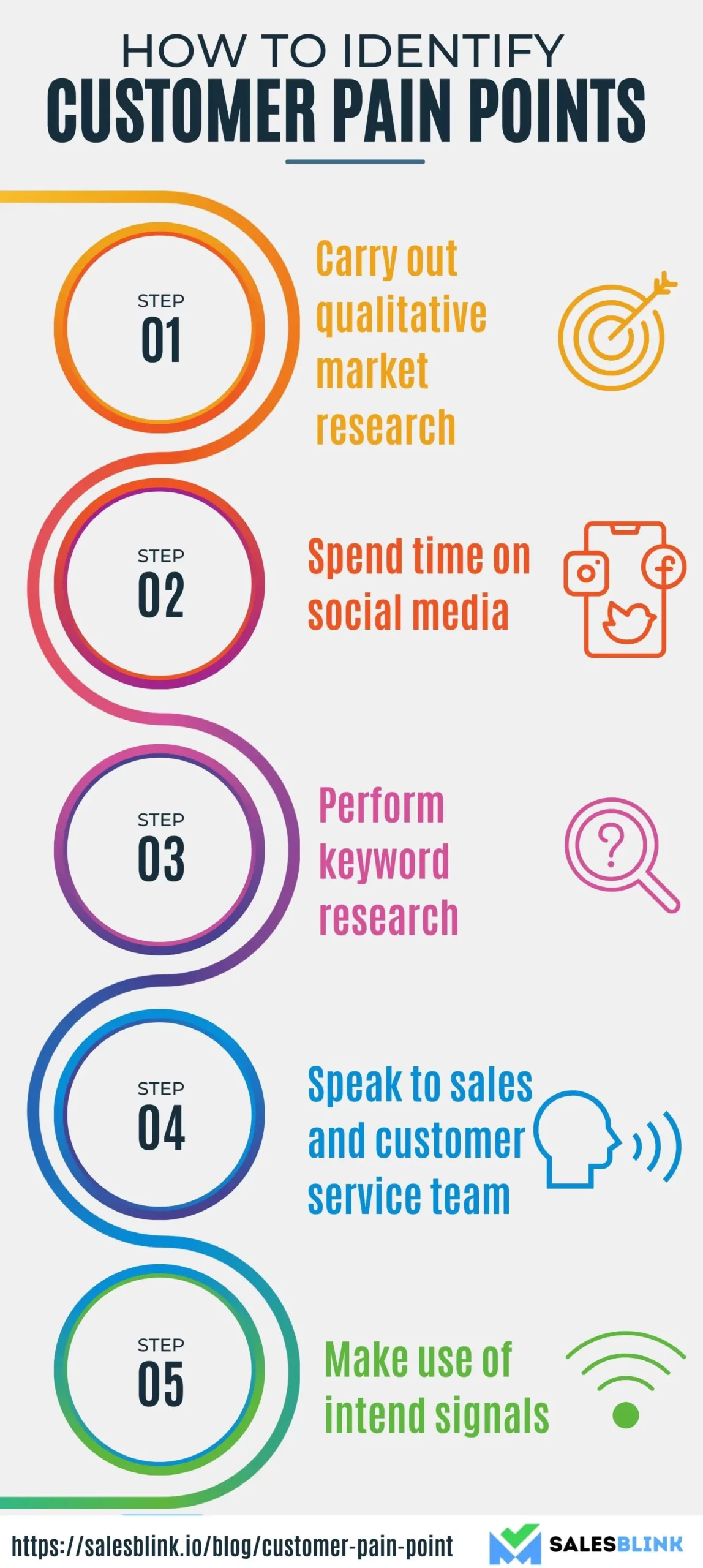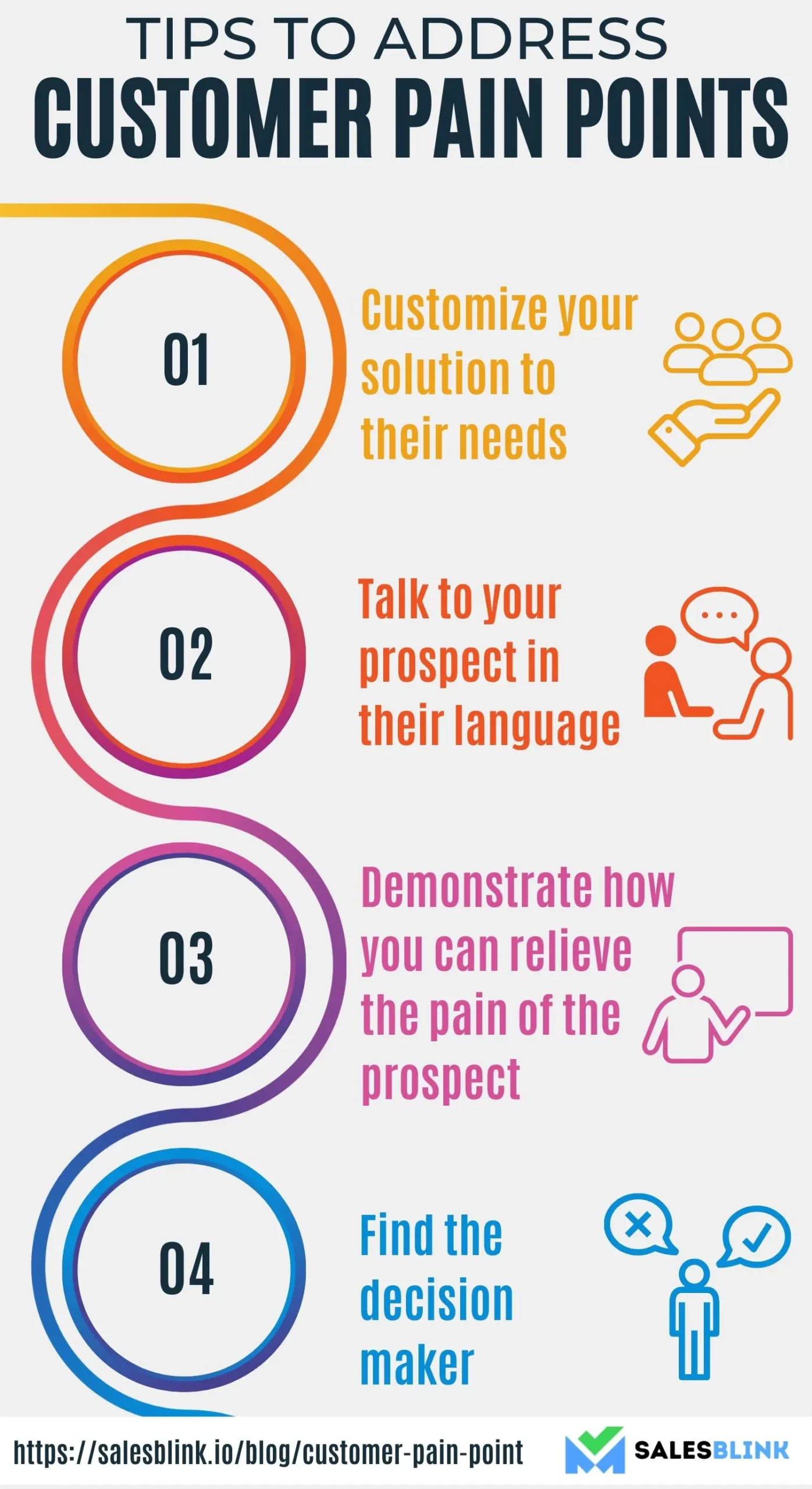The Ultimate Guide To Determine Customer Pain Points
Businesses develop products or services to satisfy the needs of their customers. It means that for a company to exist, the potential customers must have a need or a problem for which they want a solution.
It is worth noting that customer experience matters a lot. According to Stats, around 30% of customers are ready to pay more for top-notch service. There has been a 6% increase in the percentage since 2019. So, if you serve them well with your solution, they wouldn’t mind spending more.
The pain points of customers are opportunities for you, as a salesperson, to present your product or service as a solution. However, you have to first determine the pain points and if you are wondering how to do that, we are here to help you out!
So, let’s start with the meaning of business pain points and their types and the different ways to identify them.
Table Of Contents
- What Is A Customer Pain Point?
- What Is The Importance Of Pain Points?
- Types Of Customer Pain Points
- What Are The Levels Of Pain Points?
- How To Identify Customer Pain Points?
- Questions That Help Identify Customer Pain Points
- Tips To Address Customer Pain Points
- Make Use Of Customer Testimonials
- Customer Pain Point Examples In B2B Sales
- FAQs
What Are Customer Pain Points?
A pain point refers to the specific problem that a potential customer is facing which requires a solution. But identifying a pain point is as troublesome as the pain points themselves.
As a salesperson, you would want to find out the pain points to tweak your sales pitch and present your product or service as a suitable solution for their pain points. As a marketer, you want to know about the pain points to advertise your product service appealingly. Therefore, there is an importance of finding pain points in marketing as well as sales.
It may seem an easy task but determining customer pain points is not as simple as you think. The main reason is that every customer is different, and some of them don’t even know that they are facing issues. The Pulse Survey can help to define customer pain points. It is an effective tool that provides valuable information about what people want and need in their businesses, which will lead them down the path towards success.

What Is The Importance Of Pain Points?
As a salesperson, finding pain points in sales is important. When you understand the business pain points of the customer, it can be helpful in:
1. Determining whether the customer is a perfect fit or not.
2. Connecting with customers on a more personal level
3. Closing more deals
You would be addressing the problems of customers instead of mentioning the features of your product or service. You will be inclined to ask them questions to dig deeper into their problems and then present your product or service as a solution for the pain points. Read our guide on probing sales questions. If you can alleviate the pain, you will emerge as the company’s hero because, most often, one pain point can affect the whole company’s operations.
Types Of Customer Pain Points
It is plain logic that you cannot solve their problems unless you understand your customers’ pain points. All businesses revolve around providing a solution for the problems of customers through their product or service. That is why you have to study the customer pain points closely.
There are 5 main categories of customer pain points in B2B businesses, and they are the following,
1. Positioning pain points
Businesses have to establish their position in the market, but they face issues with the same. At times, they don’t know what is stopping them from doing so. They may say things like – ‘Our company is not well-known,’ ‘We are lagging because of lack of online presence.’ You will be a savior if you can identify the problem and present your product or service as a solution for it.
2. Productivity pain points
The customers may be facing a dip in productivity when the currently used solution wastes too much time. It may be stopping the employees of the customer company from executing tasks efficiently. Therefore, they are in search of an alternative that helps them make efficient use of time. Your product or service can address their productivity pain points.
3. Financial pain points
For all businesses, money is at the core of their existence. Most of the problems are mainly due to the lack of funds. One way of alleviating the pains is by sourcing sufficient finance. Businesses flourish when they are financially stable. The central pain point for a business is when they spend too much on the existing vendor. They would naturally be looking for a solution that reduces their expenditure and brings down the financial strain.
Here are some of the financial pain points that you may often hear –
- The product or service is costly.
- There is a lack of sufficient working capital.
- There is a reduction in marketing budget.
- Though we have good revenues, profits are low.
4. Process pain points
Operational problems are common. Customers feel that to scale up, they have to implement a repeatable process. They don’t know how to go about it. You have to demonstrate to customers that your solution is much easier than what they were using previously, and it can help run their business smoothly.
5. People pain points
People are the foundation of every business and are both the most significant asset and expense. When a business has problems with its people, i.e., employees, it can create other problems. The most common problems are low employee morale, losing top-notch employees to other higher-paying companies, and much more.
What Are The Levels Of Pain Points?

Pain points are of different stages. Knowing the customer is in which level will help to take the right action.
Level 1:
The customer is disappointed with their present situation but is still okay with using it.
Level 2:
The customer is sad but is still using the existing product.
Level 3:
The customer is visibly unhappy and is willing to make a switch.
Level 4:
The customer is ready to switch over and search for a solution to replace the existing tier.
Level 5:
The customer has lost the hope of finding a solution.
When the customer is in the last three stages, it is quite clear that they are more likely to pay heed to you and switch to your solution.
How To Identify Customer Pain Points?

Once you have a clear idea of the meaning of customer pain points, you must be wondering how to identify them. Here’s how you can do that,
1. Carry out qualitative market research
It is essential to find out what your customers require. You have to conduct qualitative market research that involves mapping customer journeys and analyzing the data related to prospects’ pain points.
Qualitative market research allows customers to explain the problems they are facing in detail.
Though it is possible to group pain points in categories, as we have seen above, they vary from customer to customer. It would help if you gave customers the chance to elucidate their pain points so that it is easier for you to identify them. With qualitative research, you can ask open-ended questions to customers and make the prospect answer them in detail.
2. Spend time on social media
Social media platforms are where most people ask for help. If you spend more time there, you can find out customers’ interests and what annoys them the most. You can stay on social media to detect customers’ pain points and probably draw them to your solution.
3. Perform keyword research
You can find out where the actual problem lies when you know what people search for on search engines in connection with your industry. There are several ways to do your research and find out the search queries.
4. Speak to sales and customer service teams
You have to get in touch with the teams that are in close contact with customers regularly. Which ones can be better than the sales reps and customer support teams! They have loads of information regarding the pain points of customers.
The sales reps will help you know what questions potential customers ask them and what makes them close the deal. You can understand the pain point of the customer better. For example, if your company is into SaaS sales and a prospect asks about the speed of your software to perform certain tasks, this means they are facing speed issues with their current solution.
With the help of the support team, you can find out what irritates your existing customers the most about your product or service.
For example, when customers say that “You charged extra during checkout which I didn’t expect. I won’t purchase from you again.” – this is a financial pain point from the customer’s side that you need to address. Also, you have to work towards reviewing pain points and solving them continually.
5. Make use of intent signals
When a customer has a pain point, they start with basic research online to fix it by themselves. What they usually do is visit sites, read blogs, download resources and leave behind their footprints. You can track them with intent signals. This way, it is possible to get to customers at an early stage, giving you an edge over the competitors.
Questions That Help Identify Customer Pain Points
You now have an idea of how to find the pain points of customers. However, when you are in conversation with them, you have to ask specific questions to help you dig deeper into their pain points.
You must try to ask two kinds of questions, namely open-ended questions and probing questions. It is better to avoid asking questions that the customer would answer with a simple yes or no. The aim is to make the customers explain their situation so that you can identify the underlying pain points.
Here are a few that will be helpful,
1. What affects the growth of your company the most?
As a salesperson, when you ask this question to the customer, it is like getting straight to the issue. Every business wants to grow, the hindrance to growth will naturally be a huge pain point for the customer company. Most customers would not have thought about it earlier, it makes you look like a trustworthy person. It is a polished way of getting the customers to talk about their present situation so that you can understand them better.
Most often, the pain points are capital, customers, or employees. You can come to the point by asking to follow up questions like,
How have you thought about tackling {{pain_point}}?
Do you think it is easy to solve this problem?
Who is taking care of this issue?
It will make the customer open up even more, and you can identify the pain points and make the most of the situation by presenting your product or service as a solution.
2. What is your boss obsessive about?
Likely, the person you are interacting with is not the company’s highest authority. They may be a few ranks down. However, getting the boss into the conversation is always better because they are usually the decision-making authority. You should know about the pain point they are suffering with. After all, it is the boss who will stamp the purchase contract. If the person you are dealing with doesn’t know about the boss’s plan, it is clear that the person is too inexperienced and cannot help you move the deal ahead. You can then take the right action accordingly.
3. Which task takes up the maximum time?
As a salesperson, you must have heard that the buyer is more interested in a product or service’s value rather than its features. The standard thought is – “What’s in it for me?”. Asking the customers what takes up most of their time will make the customer reveal their issues. You can ask them how solving their problem can help their business. For example, it may help them simplify a manual task and save 2 hours of their workday. This may make them take you even deeper, and you would understand how you can be of help.
4. What is discussed most often at meetings by the higher authorities?
This question is for the senior managers of a company. You must understand the difference between a trivial inconvenience and a pain point. A legit business pain affects the company’s functioning to which the top-level management does not have an immediate solution. You have to ask the customer about the usual discussion in meetings and what their main concern is. The answer to this question will lead you to the actual business pain point.
5. What are your complaints?
This question is for individuals of any level in the company. The main reason to ask this question is to find out the underlying pain point. On the surface, a complaint about lesser snacks for employees may sound like a joke, but the underlying problem may be a serious one, such as reducing the company’s budget. You would require to dig in deeper to find this out, but it will be worth it as you get to the heart of the matter.
6. What is the reason for losing deals?
The above question is for finding the pain points in the sales department of a company. You make the customer open up about the reason for losing deals. After knowing the issues, you can present your product or service as a solution that helps the prospect win more deals. This is a great approach to make the decision-maker of the company sign on the dotted line.
7. What is making the customers churn?
One of the most significant issues for any business is losing customers. Several reasons make customers churn, and you can probably present your product or service as a solution for them. The above question would take you deeper into the problems the business faces and what is inhibiting the company’s growth.
Tips To Address Customer Pain Points

Identifying the pain point is not enough. You have to find out how you can resolve the issue the customer is facing. This will help you rise above a salesperson’s position and land on the pedestal of a solution provider.
Here’s how you can address pain points effectively,
1. Customize your solution to their needs
It would help if you tried to show that your solution solves the problems faced by the customer. Catch the concepts or phrases they use while discussing their pain points and add those to your solution to personalize the pitch.
2. Talk to your customer in their language
If you want to look trustworthy, try to keep your jargon aside and talk to customers in their language. While talking about the pain point, use the terms they often use to make them feel comfortable instead of confusing them with your technical terminology. It will go a long way in impacting the customer, and they may get impacted with your approach and close the deal straight away.
3. Demonstrate how you can relieve the pain of the customer
Show customers how your solution will help alleviate the pain due to which they are suffering. Here you would need to use social proof to tell customers that your previous customers could benefit by using your solution.
4. Find the decision-maker
It would help if you tried to find the decision-maker as fast as you can. Ask your customer about the people involved in the buying decision so that you can have a detailed discussion with them about the pain point. You won’t benefit by investing time talking to those who don’t have the authority to decide.
In some cases, the customer is not the sole decision-maker but is hesitant to tell you that. Therefore, as a wise salesperson, it would be thoughtful of you if you ask them questions such as –
‘Who else has to be involved in the decision?’ or ‘Who else should know about our conversation?’ This way, you can get your answer easily.
Make Use Of Customer Testimonials
Prospects need solid proof to understand that you can help them address the issues they face. Customer testimonials can come to your rescue here. When prospects read what your existing customers say about your solution, they can trust you better. Make sure that you don’t fake it. Let the real voice of your happy customers echo in the ears of prospects.
Customer Pain Point Examples In B2B Sales
Here are a few common pain points that B2B buyers have, leading them to search for new vendors. Here is a list of the common customer pain points examples,
1. Poor service from existing vendor
If the customer is getting inadequate or unsatisfactory services from an existing vendor, they would likely want to switch to an alternative solution. An unreliable vendor can affect the functioning of a company. There can be times when the customer does not enjoy the services of the current vendor, which may vary from one customer to another but is crucial in retaining a customer.
2. Inefficient operating systems
Many businesses use software and IT products despite not being technical. Using those systems can be annoying for a layman. They may look complicated and overwhelming for small businesses that don’t usually spend too much time on the computer. The fact is that many businesses have not considered using the computer for their routine tasks. They still do a lot of them manually. They would be happy to find an automation tool that is easy to use and is standalone software.
3. Lots of vendors
Some B2B companies work with many vendors to keep the work running which can be very overwhelming. Businesses prefer having fewer vendors who can offer them more products or services. They would likely choose a vendor that provides them three services they need rather than one that offers only one service.
Start Addressing Customer Pain Points
To stay ahead of the competition, you have to possess commendable sales skills to solve customer pain points. Usually, the problem with sales pain points is that they may seem similar, but you can’t apply the same tactic for all of them. You have to address them individually and personalize the solution for the prospective customer.
Use the tactics, sales tips, and open-ended questions you saw above to determine the pain points and present your product or service as a solution. Get the customer to give you an insight into the situation they are in so that you can provide a tailor-made solution to them.
You can thank us later for hitting the sales quota!
FAQs
A pain point refers to the specific problem that a potential customer is facing which requires a solution. But identifying a pain point is as troublesome as the pain points themselves.
For all businesses, money is at the core of their existence. Most of the problems are due to the lack of funds. They would naturally be looking for a solution that reduces their expenses and minimize financial strain.
The customers may face a dip in productivity when the current solution wastes too much time. Therefore, they search for an alternative that helps them make efficient use of time.







